
Antenna
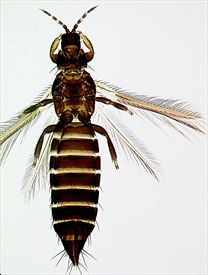
Female
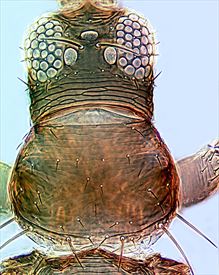
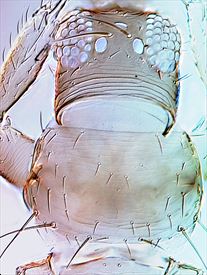

Fore wing
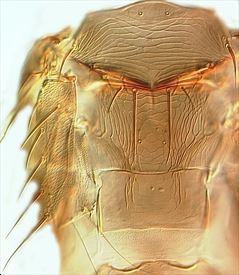
Meso & metanotum
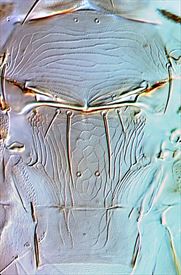
Meso & metanotum
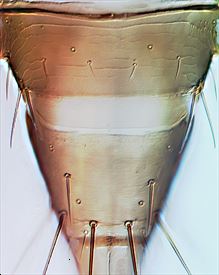
Tergites VIII-IX
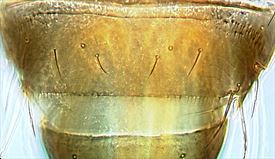
Tergite VIII
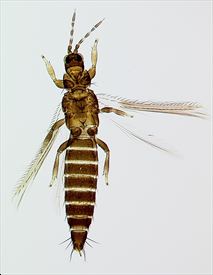
Male
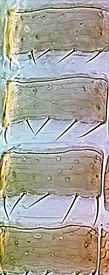
Male sternites with pore plates
Distinguishing features
Both sexes fully winged. Female dark brown, tarsi yellow, antennal segments III–IV with apical neck sharply white or yellow; fore wings brown but slightly paler at base. Antennae 8-segmented; segment I with 2 dorso-apical setae; III with 2 stout dark dorsal setae; III & IV with constricted apical neck, sense cone forked; VIII longer than VII. Head as wide as long; 3 pairs of ocellar setae, pair III just inside anterior margins of ocellar triangle, longer than distance between compound eyes; postocular setae IV as long as distance between hind ocelli. Pronotum with 2 pairs of long posteroangular setae; posterior margin with 5 pairs of setae of which the submedian pair is more than twice as long as the discal setae. Metanotum reticulate medially, campaniform sensilla present; median setae arise at anterior margin. Mesofurca with spinula. Fore wing first vein with 2 setae on distal half; second vein with complete row of setae. Tergites without sculpture between median setae, and without ctenidia; tergite VIII posteromarginal comb comprising 10–20 fine microtrichia laterally with a broad gap medially. Sternites without discal seta, median pair of marginal setae on sternite VII arise in front of margin, setae S2 closer to median setae than to setae S3.
Male similar to female but smaller and more slender; antennal segment VI unusually long; tergite IX with pair of small spine-like processes on posterior margin; sternites III–VII each with more than 25 small circular pore plates.
Related species
The genus Pezothrips currently includes nine species, of which eight are restricted in distribution to eastern and central Europe. P. kellyanus is the only member of the genus that is more widespread. This species is almost certainly native to Australia (Nguyen et al., 2015), and its generic position and relationships require further study.
Biological data
Feeding and breeding in scented white flowers of various unrelated plants, particularly Hymenosporum [Pittosporaceae] in the forests of eastern Australia, but also Citrus spp. [Rutaceae]. By feeding on very young fruits it can be a serious pest of Citrus in New Zealand, southern Australia and the Mediterranean countries.
Distribution data
Originally from eastern Australia but now widespread across that continent. Introduced to New Zealand (AK, GB), New Caledonia, Hawaii, Spain, Turkey, southern Italy, southern France, Sicily, Cyprus, and Greece.
Family name
THRIPIDAE, THRIPINAE
Species name
Pezothrips kellyanus (Bagnall)
Original name and synonyms
Physothrips kellyanus Bagnall, 1916: 219
Physothrips livii Girault, 1930: 2
References
Mound LA, Tree DC & Paris D (2012) OzThrips – Thysanoptera in Australia. http://www.ozthrips.org/
Nguyen DT, Spooner-Hart RM & Riegler M (2015) Loss of Wolbachia but not Cardinium in the invasive range of the Australian thrips species, Pezothrips kellyanus. Biological Invasions 18: 197–214.